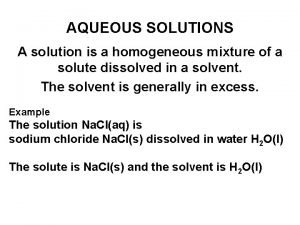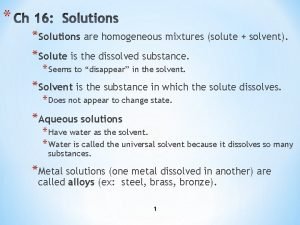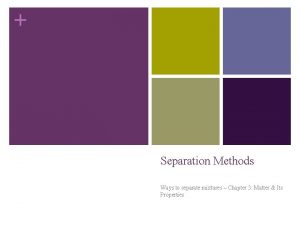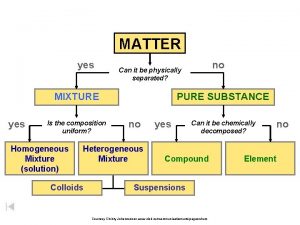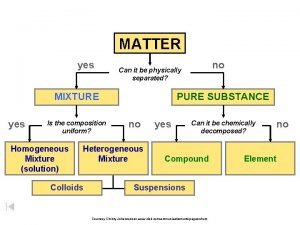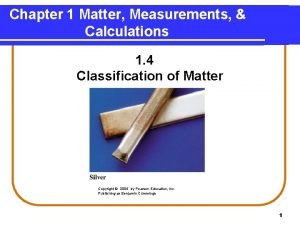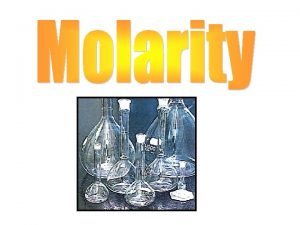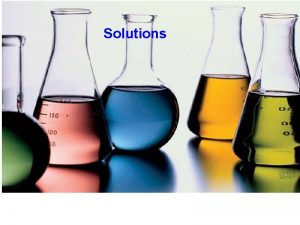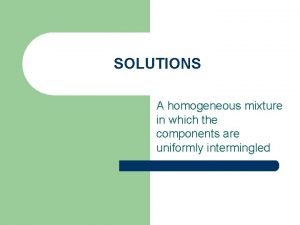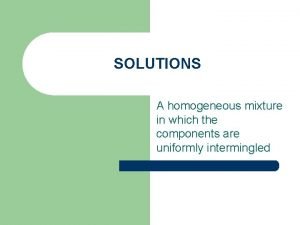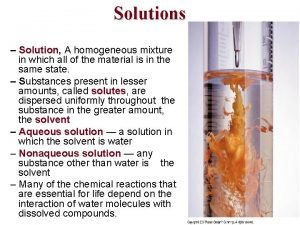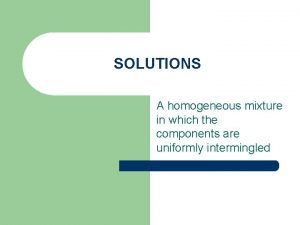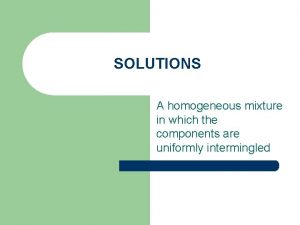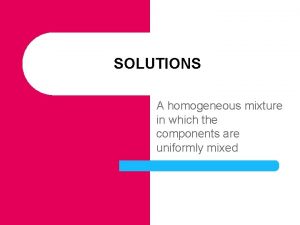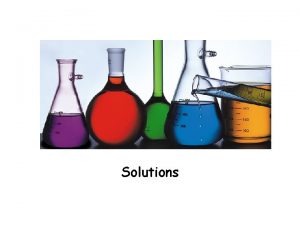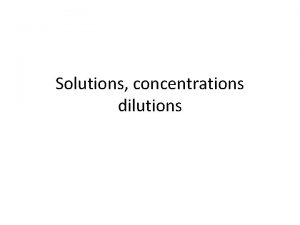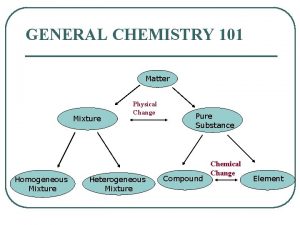Solutions A homogeneous mixture in which all of















- Slides: 15

Solutions A homogeneous mixture in which all of the particles have the sizes of atoms. Driving forces for solution formation (i) Spontaneous tendency for increasing disorder (entropy!) (ii) Intermolecular forces Sugar or alcohol in water Water and ethyl alcohol are completely "miscible". Both water and ethanol are polar molecules with hydrogen bonding. The similarity of the two molecules results in solutions where the water and alcohol molecules are interchangeable. Note that hexanol is only partially soluble in water (miscible with hexane though!). Glucose dissolves in water because polar water molecules attach to the glucose molecules by dipole-dipole (H-bond) forces. When the attractive forces of the water molecules for the glucose exceeds the attractive forces between the glucose and its neighbouring glucose molecules the water can rip the sugar molecule out of the crystal. The glucose is "solvated" when it surrounded solvent molecules. The solvent has "dissolved" the molecule.

Solution formation

Alcohol (ethanol) in water

Engine coolants • We can now explain why car radiator coolants dissolve in water. The coolants typically contain either ethylene glycol or propylene glycol, which, like ethanol and water, contain hydrogen-bonding O-H bonds.

Solublility & Miscibility (like dissolves like)

How do stain removers work? • Like dissolves like dry cleaning, surfactants and oxidizing agents (and enzymes!)

Energy Changes and Solution Formation Heat of solution: The enthalpy change between system and surroundings when 1 mole of a solute dissolves in solvent at constant pressure - In general, solutions form when Hsoln is negative. -When Hsoln is too positive, a solution will not form. -Heat of solution is zero for an ideal solution Examples: Mg. SO 4 added to water has Hsoln = -91. 2 k. J/mol. NH 4 NO 3 added to water has Hsoln = + 26. 4 k. J/mol. Mg. SO 4 is used in hot packs and NH 4 NO 3 is used in cold packs.

Ideal dilute solutions-effect of pressure on solubility PB = x. BKB

Pressure and Solubility • “The Bends” - deep sea divers – N 2 in compressed air has low solubility in blood. At great depths, partial pressure of N 2 increases and solubility increases. After returning to surface, solubility decreases substantially and N 2 come out of blood causing small bubbles in the capillaries which may rupture the blood vessels - fatal - risk reduced if He is used since it has lower Henry’s constant. • Soft drinks and champagne – produced by dissolving CO 2 in a liquid under pressure – opening bottle reduces the partial pressure of CO 2 above solution, solubility reduced, CO 2 leaves solution (effervescence)

Colligative Properties of Solutions Physical properties that depend only upon the populations of particles in a mixture Effect of solutes on the vapour pressure of solutions Psoln = xsolvent. P*solvent Raoult’s Law Molecular interpretation of Raoult’s Law

Volatile solutes and Raoult’s Law Each component contributes its own partial pressure to the solution vapour pressure (Dalton’s Law) Real mixtures Deviations because of intermolecular attractions Application: Distillation

Distillation

Boiling point elevation Freezing point depression Entropy effect (see later): when a solute is added to a pure liquid, the entropy (disorder) is increased relative to the vapour phase. Therefore there is a weaker tendency to form a vapour (boiling point elevation). A similar molecular interpretation explains freezing point depression. The effect shifts the s-l and l-g vp curve of a phase diagram down. Applications: ØCooking ØDe-icing and anti-freeze ØMolar mass determination

Osmotic pressure Osmotic membrane: semi-permeable membrane that allows passage of only solvent molecules Dialysis membrane: membrane that allows passage of solvent and small solutes. Van’t Hoff equation Applications: ØReverse osmosis ØCrenation and hemolysis of red blood cells ØMolar Mass determination

Colligative properties of solutions of electrolytes 1. 00 m Na. Cl: F. P= -3. 37 C (not – 1. 86 C as expected)! Colligative properties depend on the concentration of particles Remember: Na. Cl Na+ + Cl. We have 2. 00 m of particles and should get F. P: -(2 x 1. 86 C) = -3. 72 C Effect of interionic attractions account for discrepancy between actual and calculated F. P. for ionic species. Van’t Hoff Factor compares degrees of dissociation of electrolytes
 Homogeneous mixture and heterogeneous mixture class 9
Homogeneous mixture and heterogeneous mixture class 9 Are all solutions homogeneous mixtures
Are all solutions homogeneous mixtures Are all aqueous solutions homogeneous
Are all aqueous solutions homogeneous Are all aqueous solutions homogeneous
Are all aqueous solutions homogeneous Homogeneous and non homogeneous differential equation
Homogeneous and non homogeneous differential equation A homogeneous mixture of a solute and solvent
A homogeneous mixture of a solute and solvent Decanting
Decanting Matter that has a uniform and definite composition
Matter that has a uniform and definite composition Composition of matter flow chart
Composition of matter flow chart State of matter
State of matter Chemistry homogeneous mixture
Chemistry homogeneous mixture Non examples of homogeneous mixture
Non examples of homogeneous mixture Blood is heterogeneous mixture
Blood is heterogeneous mixture What is a solution homogeneous mixture
What is a solution homogeneous mixture Homogeneous mixture
Homogeneous mixture Compounds and mixtures worksheet
Compounds and mixtures worksheet



